BY JEANNE DORIN MCDOWELL
Photographed by David Strick
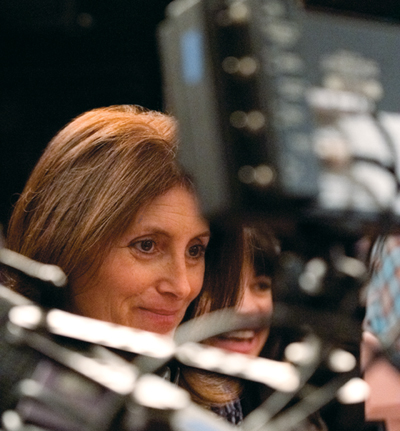 ON YOUR MARK: Pamela Fryman sets the tone on the set and says
ON YOUR MARK: Pamela Fryman sets the tone on the set and says
"I want this to be a happy, respectful, nurturing place."Neil Patrick Harris' physicality is hilariously on display during the filming of a recent episode of the hit comedy How I Met Your Mother. Director Pamela Fryman watches from nearby monitors as Harris, who plays the womanizing Barney, flails around the kitchen after stuffing a jalapeño pepper, then a mound of spicy wasabi into his mouth to show off his machismo. He drops onto all fours at one end of the couch, pops up at the other end, and falls against the stove, choking and grasping his throat. The kitchen set is crowded, and the point is to capture Harris' antics on camera while making sure the faces of the two other actors in the frame can also be seen. Fryman steps out from behind the monitors and fires a sequence of simple directions at Harris and the camera operator so as not to interrupt the action. When the scene is completed she walks up to Harris, plants her hands on his shoulders and looks him squarely in the eyes. "Neil, that was amazing," she says.
At first glance this appears to be a standard sitcom. But, in fact, there is very little that is typical about How I Met Your Mother. Unlike conventional sitcoms, HIMYM is a multi-camera comedy that, at times, looks and acts like a single-camera show. Episodes typically contain between 60 and 80 scenes, which is a mind-boggling number compared to the average 10 scenes in most network sitcoms. While sitcoms are usually filmed in one day, HIMYM shoots over three 10-12 hour days.
"We do so many scenes, but because we shoot on a sitcom stage we don't always have room for all the sets," notes unit production manager and producer Suzy Mamann-Greenberg. "Every episode has its own problems, and with 70 to 90 wardrobe changes we have a heavy load."
With the central premise being a man telling his kids how he met their mother years before, each episode is told in the past tense and filled with flashbacks and flash-forwards, requiring consistency, seamlessness and tracking. And there is no live audience to tell the director, actors and producers if the humor is working.
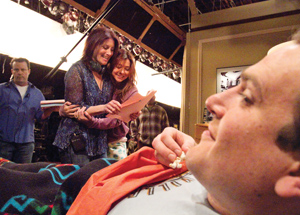 SHOW TIME: 1st AD Michael Shea, Fryman and Hannigan get
SHOW TIME: 1st AD Michael Shea, Fryman and Hannigan get
ready to shoot a bedroom scene with Jason Segel.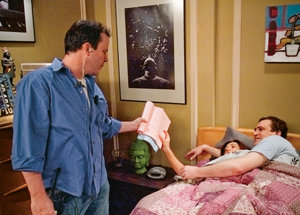 Shea preps the the actors.
Shea preps the the actors.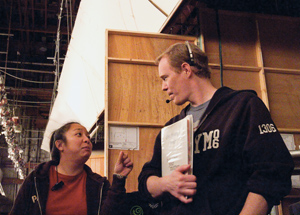 2nd 2nd ADs Janssen Riofrir and Chris Hyssong keep the ball rolling.
2nd 2nd ADs Janssen Riofrir and Chris Hyssong keep the ball rolling."On this show a lot of comedy comes from being cut and pasted in the editing room, rather than jokes in a scene," says Fryman during a break from shooting on the 20th Century Fox lot. "When you put it together, that's where you reveal the funny. The punch line comes in the edit."
For Fryman, who has done extended stints on such shows as Frasier, Just Shoot Me! and Two and a Half Men, the challenges on HIMYM have only added to her already-considerable arsenal of skills. She has directed all but a few episodes of the show since its premiere in 2005 and also functions as the executive producer. Her directorial team, whom she heartily credits with the show's success, is a cohesive and close-knit unit. In fact, HIMYM is arguably the happiest and huggiest set in television. And at the center is Fryman, a calming presence to the band of actors she jokingly refers to as "my children, my adorable children."
"Some directors are good with people and others have analytic computer brains that can handle looking at four screens at the same time," says Carter Bays, the show's co-creator (with Craig Thomas) and executive producer. "Ninety-nine percent of the time those traits are mutually exclusive. But Pam has them both. She can multitask like no one I've ever seen, but at the same time is the warmest, most accessible person you will ever meet."
Even though it's Wednesday, the first day of shooting, the mood on set is relaxed and unfrenzied. First assistant director Michael Shea is perusing the set checking to see that all of the actors in the next scenes are there. This week the main story arc revolves around Marshall (Jason Segel) and Lily (Alyson Hannigan) deciding that they will get a better night's sleep in separate beds. Fryman directs Hannigan on how to place her body in the bed in relation to Segel and the camera and calmly re-shoots the scene several times. Associate director Jim Rose serves as Fryman's second set of eyes and makes sure she gets the shots she wants.
With only 44 scenes, this is considered a light episode by HIMYM standards. Most of the scenes contain only two people. There are no major stunts and only one exterior scene on the New York City street, which will be filmed on Thursday. Often the staging is more complicated, with Fryman and her team pulling off some of television's most ambitious productions. For instance, for the show's 100th episode last January, Fryman staged a Busby Berkeley-type musical number that required 65 dancers and more than 20 set changes.
One of the most memorable shows, Fryman recalls, was an episode in season three entitled "Ten Sessions." In the story line, Ted (Josh Radnor) wants to woo Stella (Sarah Chalke), who explains that she only has a few minutes for lunch. What ensued was the "two-minute date," which included small talk, dinner, a movie, coffee, two cab rides and a goodnight kiss, all in 120 seconds. The entire scene was filmed in a single shot without any breaks or editing.
"If we had made it more than one shot it would have lost its magic," explains Fryman. "The audience needed to feel like they were out on the date with the couple. As the actors moved down the street, passing the various props and set dressings, the crew would be right behind them changing sets. The hard part was getting everyone to do exactly the same thing at the same time."
Fryman concedes that working on HIMYM requires her to operate in a different way than she has on other sitcoms. Because much of the show consists of telling stories about what happened in the past, Fryman often "bundles" scenes, shooting four consecutively on the same set and then cutting in and out to accommodate the flashbacks and flash-forwards. "A primary scene," explains Shea, "is usually cut up three or four times."
The style of the show sometimes requires shooting on the fly. "We're still rehearsing even when we start shooting," notes Fryman. "We're refining and refining while the cameras are rolling. I can't spend time looking at my script because so much is happening on stage. I don't have the luxury of shooting a scene, then thinking, 'can I do something different or better?'"
This is not how she learned her craft. "I have never directed a show like this. I was trained to make notes, but I direct this show out there," Fryman says, motioning toward the stage. "I used to write down every shot, even if two people were sitting at a table for 10 pages of a script. Now, if you look at my script you won't think I've even read it. It's a different way of working. But it's made me a better director."
Fryman has a supportive team that is acutely aware of how the director works and is fiercely devoted to helping her express her vision. During scenes on the MacLaren's Bar set, where a good deal of the drama and comedy take place, Fryman wants actors immersed in the activity rather than standing close to the camera surrounded by it. "She likes action," says 2nd 2nd AD Chris Hyssong. "If the bar is feeling flat, then we lose the energy of the scene for the director." To achieve this, Fryman uses a lot of extras and background actors moving in the foreground in front of lead characters. "Pam will call for background action," says Hyssong. "Then she calls separate action for the cast actors. She wants to bring the world alive and create that hustle and bustle in the bar before actors start."
The skill with which Fryman now directs an episode of HIMYM has developed over time. But when she read the first script for the series she says the sheer number of scenes seemed like a logistical nightmare. It became clear pretty quickly that this wasn't a sitcom that could be shot in front of an audience "unless we had a lot of close friends and family members who owed us a lot of favors," Fryman jokes. She and the executive producers argued and won their bid to shoot without an audience, instead using a deftly placed laugh track.
"It was all an unknown," recalls the director. "We kept looking at each other, taking each other's temperatures. But as we watched the chemistry unfold between cast members, we knew the pieces would fit together. We saw that it was funny."
Today, most of the kinks have been worked out and Fryman and her team do, in fact, operate like a well-oiled machine. The process begins on Friday evening, when Fryman and 1st AD Michael Shea get copies of the script for the following week's show. They e-mail and talk over the weekend, and Fryman starts picturing the scenes in her head. Shea, who had never worked with Fryman before signing on at the start of HIMYM, creates a master schedule for the week with the goal to plan as economically as possible. The schedule ensures that actors are on set only when they are needed rather than having to spend hours waiting around. "On Sunday I break down the script figuring out what order we will shoot on Wednesday and what that leaves for Thursday and Friday," says Shea. "I keep everyone's schedule in mind knowing that they have busy lives. Getting this show completed in a week is always a feat."
"When Michael puts together the schedule he always nails it," Fryman says of her 1st AD. "I'm telling you, 95 percent of the time when Michael says we will be out, we're out."
At a Monday morning production meeting, the team figures out how they're going to do the flashbacks. This often requires going back into the archives to see what characters were wearing or how they looked months before when the original scenes were shot. Tuesday is a day for a run-through, and shooting begins at 9 a.m. Wednesday when Shea welcomes everyone to the set. Typically, interior shooting happens on Wednesday and Friday and outside scenes on the New York street are filmed on Thursday.
Fryman picked up many of the skills that serve her on HIMYM working on the daytime soap opera Santa Barbara. "I'm fast and pretty unflappable," she says. "You can rewrite a scene completely and I'm not thrown by it."
Growing up in Philadelphia, Fryman never considered a career in television working on sitcoms or soaps. Instead, she figured she'd follow in her father's footsteps in merchandising. But on a trip to Los Angeles in 1980, the then 21-year-old college grad met up with some friends who were working in television. When Fryman got her first job as assistant to the talent coordinator on The John Davidson Show, her father predicted she'd be home in three weeks. From there Fryman became a booth production assistant and secretary on Santa Barbara.
"I wanted to do it forever because I got to be in the booth and work with actors," she recalls, "and the next day we put the show together in the editing room." I learned how to put a show together from the bottom up." Eventually, Fryman moved up to AD, then director.
In 1993, producer Peter Noah, with whom she had worked on the game show Dream House, gave Fryman a chance to direct an episode of the short-lived sitcom Café Americain. That was it; Fryman went on to become one of the most highly regarded and sought-after directors in television comedy. Along the way, she has won two Daytime Emmys, both for Santa Barbara, and has been nominated for four DGA Awards, three for directing Frasier and one for Just Shoot Me!
"Directing is like putting the pieces of a puzzle together," Fryman says. "I'm very organized. I like lists. I was the girl who came home and copied everything over. And I was very conscious of wasting people's time on the set. Working for directors who are not on their game made me conscious of the responsibilities of the job."
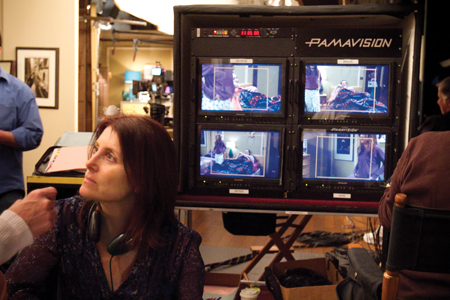 Co-creator Carter Bays says Fryman is one of those rare directors who is good with people
Co-creator Carter Bays says Fryman is one of those rare directors who is good with people
and has an "analytic computer brain that can handle looking at four screens at once."This season, Fryman will be taking some time off from HIMYM to direct three pilots for next season, something she does if she loves the material or the people who created it. "On a pilot it's all new information — characters, sets, story, everything," says Fryman. "What works? What doesn't? There are lots of opinions and the director has to be flexible, listen to all the information and find a way to make everyone feel heard. It can be a bit overwhelming, but being on the ground floor of the creative process is a spectacular experience." And wherever she goes, whenever possible, she takes her team. She jokes, "I'll say to them, 'C'mon guys, we got a gig!'"
When she's finished with the pilots, Fryman says she will happily return to HIMYM. "What's fantastic on this show is that everyone has a role to play here, which is why it's such an exciting place to spend my days. There are a million elements, and it often takes a lot of rehearsal. But what makes it fun for me is that it's not about one person doing their job. Everybody has to hit his or her mark for it to work. It's always challenging and a group effort."